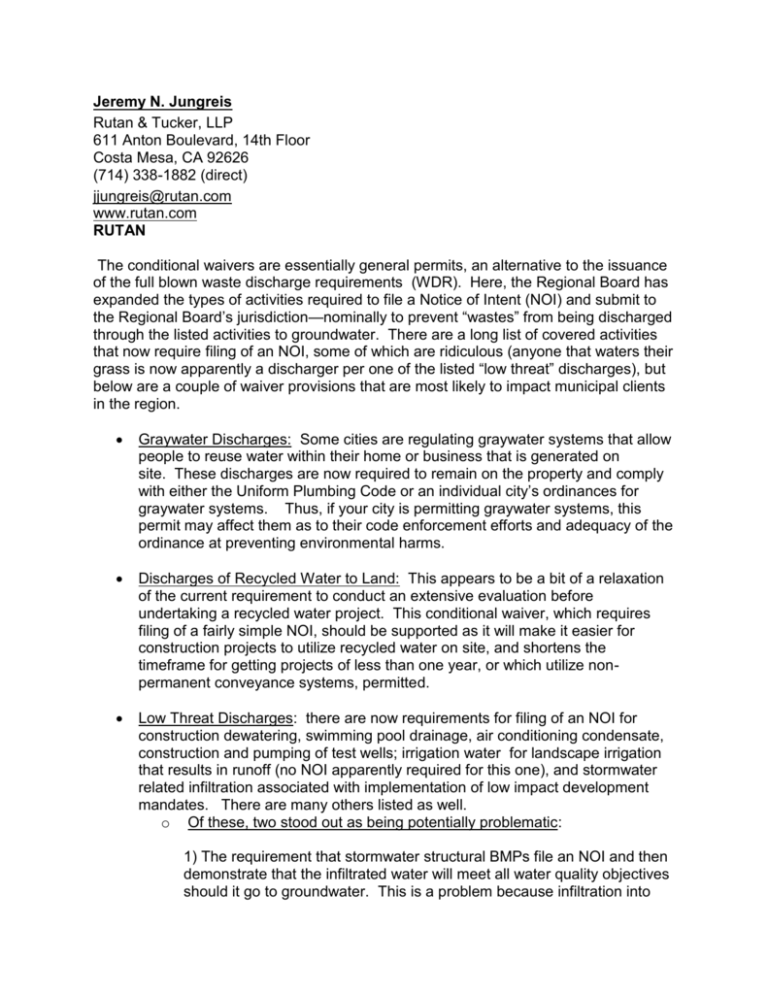Jeremy-Jungreis-comments-on-Cond-Waivers-for-low
advertisement

Jeremy N. Jungreis Rutan & Tucker, LLP 611 Anton Boulevard, 14th Floor Costa Mesa, CA 92626 (714) 338-1882 (direct) jjungreis@rutan.com www.rutan.com RUTAN The conditional waivers are essentially general permits, an alternative to the issuance of the full blown waste discharge requirements (WDR). Here, the Regional Board has expanded the types of activities required to file a Notice of Intent (NOI) and submit to the Regional Board’s jurisdiction—nominally to prevent “wastes” from being discharged through the listed activities to groundwater. There are a long list of covered activities that now require filing of an NOI, some of which are ridiculous (anyone that waters their grass is now apparently a discharger per one of the listed “low threat” discharges), but below are a couple of waiver provisions that are most likely to impact municipal clients in the region. Graywater Discharges: Some cities are regulating graywater systems that allow people to reuse water within their home or business that is generated on site. These discharges are now required to remain on the property and comply with either the Uniform Plumbing Code or an individual city’s ordinances for graywater systems. Thus, if your city is permitting graywater systems, this permit may affect them as to their code enforcement efforts and adequacy of the ordinance at preventing environmental harms. Discharges of Recycled Water to Land: This appears to be a bit of a relaxation of the current requirement to conduct an extensive evaluation before undertaking a recycled water project. This conditional waiver, which requires filing of a fairly simple NOI, should be supported as it will make it easier for construction projects to utilize recycled water on site, and shortens the timeframe for getting projects of less than one year, or which utilize nonpermanent conveyance systems, permitted. Low Threat Discharges: there are now requirements for filing of an NOI for construction dewatering, swimming pool drainage, air conditioning condensate, construction and pumping of test wells; irrigation water for landscape irrigation that results in runoff (no NOI apparently required for this one), and stormwater related infiltration associated with implementation of low impact development mandates. There are many others listed as well. o Of these, two stood out as being potentially problematic: 1) The requirement that stormwater structural BMPs file an NOI and then demonstrate that the infiltrated water will meet all water quality objectives should it go to groundwater. This is a problem because infiltration into the ground is generally MANDATED by the LID requirements of the MS4 Permit for New or Modified developments. If you are required to infiltrate as part of meeting the LID requirements for new construction, which the Cities must generally enforce, then how can you then mandate a showing that the water infiltrated doesn’t contain pollutants exceeding water quality objectives? Taking this conditional waiver, combined with the mandates for LID in the Regional MS4 Permit to their logical conclusion, you would basically wind up in a situation where there would be no way to comply for new construction or stormwater retrofits. If you don’t do LID, you are out of compliance. If you do LID and put stormwater (generally containing pollutants in an urban environment) in the ground, then you are still out of compliance. You can’t show, necessarily, that the water infiltrated actually meets water quality standards. Clear as mud, right? That’s the point, the Regional Board needs to clarify that compliance with the MS4 Permit retention/infiltration requirements obviates the need for obtaining a conditional waiver—no matter what. 2) The requirement to obtain a waiver for discharges of test pumping of potable wells to land. Problem for municipal dischargers is that there may be constituents in the water like MTBE or salinity that are above the water quality objectives (and are generally removed via treatment at the treatment plant). Municipal dischargers should ensure that normal flushing of wells is not going to require obtaining a separate WDR because of legacy contaminants and naturally existing high salinity.











